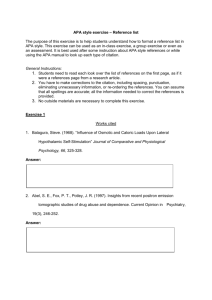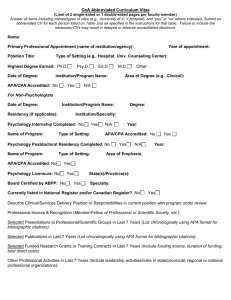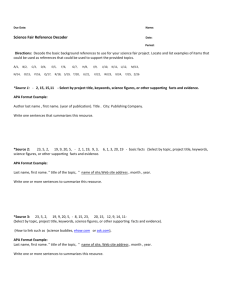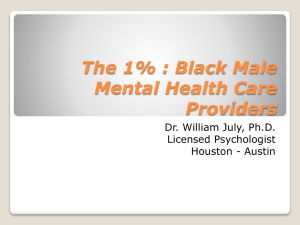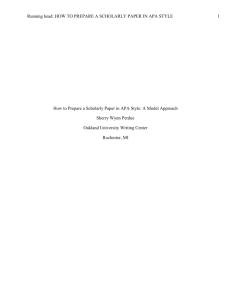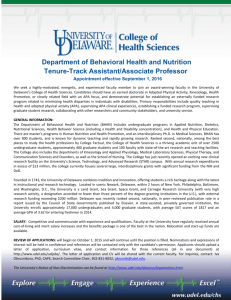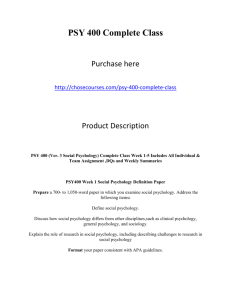step 2: annotated bibliography
advertisement
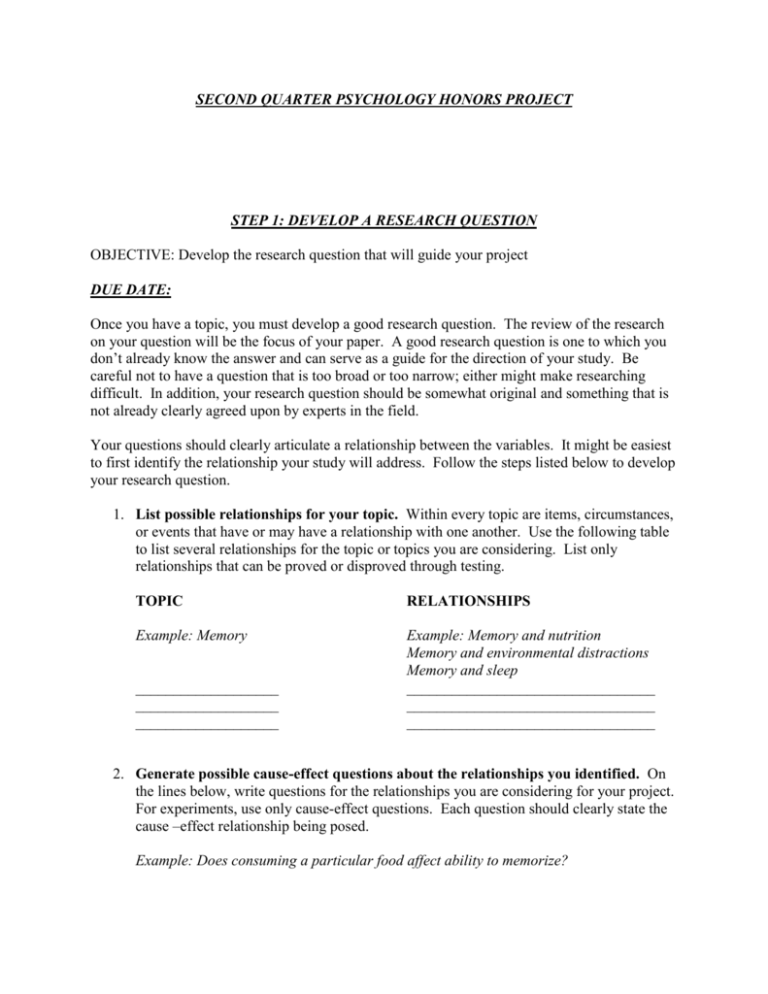
SECOND QUARTER PSYCHOLOGY HONORS PROJECT STEP 1: DEVELOP A RESEARCH QUESTION OBJECTIVE: Develop the research question that will guide your project DUE DATE: Once you have a topic, you must develop a good research question. The review of the research on your question will be the focus of your paper. A good research question is one to which you don’t already know the answer and can serve as a guide for the direction of your study. Be careful not to have a question that is too broad or too narrow; either might make researching difficult. In addition, your research question should be somewhat original and something that is not already clearly agreed upon by experts in the field. Your questions should clearly articulate a relationship between the variables. It might be easiest to first identify the relationship your study will address. Follow the steps listed below to develop your research question. 1. List possible relationships for your topic. Within every topic are items, circumstances, or events that have or may have a relationship with one another. Use the following table to list several relationships for the topic or topics you are considering. List only relationships that can be proved or disproved through testing. TOPIC RELATIONSHIPS Example: Memory Example: Memory and nutrition Memory and environmental distractions Memory and sleep _________________________________ _________________________________ _________________________________ ___________________ ___________________ ___________________ 2. Generate possible cause-effect questions about the relationships you identified. On the lines below, write questions for the relationships you are considering for your project. For experiments, use only cause-effect questions. Each question should clearly state the cause –effect relationship being posed. Example: Does consuming a particular food affect ability to memorize? ________________________________________________________________________ ________________________________________________________________________ ________________________________________________________________________ 3. Narrow and refine the question. After choosing a question, rewrite it on the lines below until it clearly states in as few words as possible a question that you can test during your research. Example: Can drinking a high-glucose diet improve memory? ________________________________________________________________________ ________________________________________________________________________ ________________________________________________________________________ 4. Check and Edit your question. Check your final question for correct spelling, grammar and length (the shorter the better). Is the question too broad or too narrow? Is this a question you care enough about to spend a couple of months with? Will you be able to find an adequate amount of sources for your topic? 5. Type the question on a separate sheet of paper and turn it in by the due date. STEP 2: ANNOTATED BIBLIOGRAPHY You will be turning this part of the project in electronically on turnitin.com You will need the following Class ID #______________________________ And your password is____________________________________________ OBJECTIVE: Obtain and review 6-8 scholarly sources for a literature review of your subject DUE DATE: You must find six to eight sources for your research paper. An annotated bibliography is a specific listing of each source, followed by a brief statement about what this source says, and how you will use it in your research. You must use proper APA (American Psychological Association) reference format. Refer to the examples near the back of this manual or go to www.apa.org for help with APA format. Note: Be sure to use as many scholarly sources as possible. Articles from scientific journals are the only acceptable sources for this assignment. Unacceptable sources include popular magazines, self-help books, and Oprah transcripts. Our library has some of the finest researchers just waiting to help you. Take advantage of their expertise. Finding Articles for the Literature Review The BHS library has access to a database called “PsychNET”, which is devoted entirely to peerreviewed psychology journal articles. You can ask the librarians to help you to search for relevant articles using this database. Example: Jacobson, J. (2004). The link between memory and nutrition. Journal of American Psychology. 24(3). Pgs. 145-152. This article summarizes an experiment conducted by James Jacobson which found there is a strong link between memory and the amount of fiber consumed by the average American. Jacobson found that the more fiber someone consumes, up to a certain point, there are noticeable improvements in the person’s memory. This study will be important to my research because it helps me to establish a link between memory and nutrition. The study also gives me several good examples about how to conduct my research. STEP 3: LITERATURE REVIEW You will be turning this part of the project in electronically on turnitin.com You will need the following Class ID #______________________________ And your password is____________________________________________ Due Date: This is where you actually write your final paper. The APA format for the Literature is explained in the accompanying documents. A Literature Review is a systematic analysis of what has already been said about a particular topic. This portion of the paper should summarize all of the articles that you have collected through your literature search and emphasize the overviews of what the larger bodies of literature have to say. The review should begin with a general statement about the topic to be studied and move to more specific examples. If numerous authors have studied similar issues, those topics may be discussed together, however all authors must be cited. This should NOT be a section describing what each paper was about, but rather should use the resources that you have collected to support your research topic. Steps in conducting a Literature Review After gathering the literature, sort it into logical groupings and examine the literature in each group looking for agreement or disagreement. Examine the group to see if there are holes in the literature (areas not well covered) or if new questions come to mind after having read the literature. Your literature review should detail and summarize the literature in each group with your own conclusions at the end of each section Summarize the literature review at the end by giving an overview of the literature and discussing the problems or opportunities (holes) you found. You should also give an indication of what you see as potential for future research in the area. The final paragraph usually contains a statement which clearly and explicitly states why your study was performed. Be careful not to us a sentence of this type earlier in your introduction This section should contain an absolute minimum of four paragraphs: the general introduction, the literature review (usually longer than one paragraph), the connection of your study to the literature, and an explicit statement of purpose

